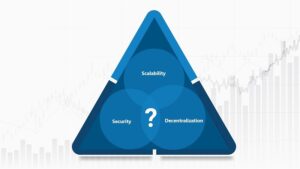When Bitcoin first used blockchain technology in 2009, it promised a future where money could be sent and received quickly, safely, and without being controlled by a central authority. Over the years, blockchain has been used for a lot more than just cryptocurrencies. It’s been used for everything from managing supply chains to creating digital identity systems. But as the ecosystem grew up, a big technical problem called the Blockchain Trilemma started to show up.
This blockchain trilemma shows how hard it is to reach all three of a blockchain system’s main goals: scalability, security, and decentralization. People all over the world, especially in the U.S., are working hard to solve this technical puzzle.
Let’s look at what the blockchain trilemma is, why it matters, and how some of the smartest people are trying to solve it.
What does the Blockchain Trilemma mean?
Vitalik Buterin, one of the founders of Ethereum, made the term “Blockchain Trilemma” popular. The idea is that a blockchain can only make two of the following three properties better at a time:
Security: The system must be able to withstand attacks and tampering. Decentralization means that not a few people should have all the power. Instead, many nodes share control. Scalability means that the system can handle a lot of transactions every second.
Let’s use simple comparisons to break these down.
You want your system to be as hard as possible for hackers to get into, just like building a fortress. Decentralization means that no one person or group is in charge—it works like a town hall where everyone can speak. Scalability is like making a highway bigger so that more cars (transactions) can get through without getting stuck.
Sadly, it has been very hard to do all three at the same time.
Why can’t we have all three?
Think about running a blockchain that is very safe and not controlled by one person. Every computer in your network needs to check every transaction. This takes time and effort, which slows things down and makes it impossible to grow.
On the other hand, if you care more about speed and scalability (like with traditional databases), you might have to use fewer nodes or even central authorities to process data quickly. That makes the system less decentralized and maybe more open to attacks, which means it’s less secure. This deal is what the blockchain trilemma is all about.
The Trilemma in the Real World
Bitcoin: Very safe and decentralized, but slow. It can only handle about 7 transactions per second (TPS), which is very small compared to Visa’s 24,000 TPS.
Ethereum (before 2.0): It was more flexible than Bitcoin, but it still had trouble scaling when the network was busy. Do you remember the CryptoKitties craze? The entire Ethereum network became slower.
Solana is a blockchain that focuses on high throughput (scalability) and can handle thousands of TPS. But some people have said that it is too centralized because it only uses a few validator nodes. Depending on its goals, each blockchain makes trade-offs.
How are developers dealing with the blockchain trilemma?
To solve the blockchain trilemma, you need to make creative choices about architecture. Here’s how different technologies are dealing with the issue:
- Solutions for Layer 2 Scaling
Layer 2 (L2) solutions are built on top of blockchains in Layer 1, like Ethereum. They do most of the work off-chain and then send the final data back to the main blockchain. Optimistic Rollups, zk-Rollups, and the Lightning Network (for Bitcoin) are some examples.
Impact: They help make things more scalable without sacrificing security or decentralization because they inherit the security of the base layer.
- Sharding
Sharding splits the blockchain into smaller, easier-to-handle pieces called shards, each of which handles its own transactions.
How it helps: Not every node has to check every transaction, which speeds things up.
Ethereum adopted it as part of the Ethereum 2.0 upgrade roadmap.
- New consensus mechanisms and proof-of-stake (PoS)
Blockchains use consensus to agree on what is true. Proof-of-Work (PoW) is safe, but it uses a lot of resources. Proof-of-Stake uses less energy and can handle more transactions.
Ethereum 2.0, Cardano, and Polkadot are some examples.
Bonus: PoS gives people reasons to keep things decentralized.
- Blockchain Design with Modules
Some new blockchains don’t do everything (consensus, execution, data availability) on one chain. Instead, they break the architecture up into layers.
Celestia (modular data availability) and Dymension (RollApp-specific modular chains) are two examples.
The result is that customization and scalability are better, but decentralization and security are not affected.
- Protocols for interoperability
Polkadot, Cosmos, and Chainlink CCIP are all projects that want to make sure that blockchains can talk to each other safely. This helps spread the load across chains, which makes them more scalable while keeping them decentralized.
What Does This Mean for Blockchain’s Future?
The U.S. is a world leader in blockchain innovation, and how the trilemma is solved will decide how blockchain affects big industries like finance, healthcare, logistics, and governance.
If developers can get around the blockchain trilemma, we might see a lot of people use decentralized apps (dApps) that are fast and easy to use. A safe, decentralized financial system that doesn’t depend on big banks. Voting and identity verification are examples of public services that run on tamper-proof blockchains.
But if we don’t fix it, users might stick with centralized options, which goes against the whole point of blockchain.
Is it possible to completely solve the blockchain trilemma?
Some experts say that the blockchain trilemma is not a law, but a problem that can be solved in a smart way. Developers don’t think in terms of “yes” or “no.” Instead, they look for “sufficient decentralization, acceptable security, and practical scalability.”
In real life, context matters: A blockchain for a global currency, like Bitcoin, will put security and decentralization first. A gaming blockchain might put speed and scalability first. A blockchain run by the government might find a way to balance all three by having stricter rules for validators.
So, instead of choosing just one solution, we think that in the future there will be many blockchains that serve different purposes.
Final Thoughts: Making Things Smarter, Not Just Bigger
The blockchain trilemma isn’t a dead end; it’s a design problem. As U.S. lawmakers become more open to cryptocurrency, and Web3 startups keep growing, the need to create systems that can grow, are safe, and are not controlled by one person is stronger than ever.
If you want to be able to critically evaluate blockchain projects, you need to understand this trilemma. It doesn’t matter if you’re a developer, an investor, or just interested in the tech.
The next time you hear about a new crypto or blockchain platform that says it can “solve everything,” think about what they’re giving up. In the world of blockchain, the best new ideas often come from smart compromises.
For more updates visit us: InfoDaily












